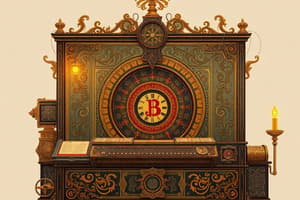Podcast
Questions and Answers
Which machine did Alan Turing work on to break the German Enigma code in World War II?
Which machine did Alan Turing work on to break the German Enigma code in World War II?
- Colossus (correct)
- Enigma
- Turing Machine
- Computable Numbers
When did Alan Turing publish the paper titled 'On Computable Numbers with an Application to the Entscheidungsproblem'?
When did Alan Turing publish the paper titled 'On Computable Numbers with an Application to the Entscheidungsproblem'?
- 1936 (correct)
- 1954
- World War II
- 1912
What was the main focus of Alan Turing's paper 'On Computable Numbers with an Application to the Entscheidungsproblem'?
What was the main focus of Alan Turing's paper 'On Computable Numbers with an Application to the Entscheidungsproblem'?
- Developing the first digital computer
- Proving the existence of effective procedures in mathematics (correct)
- Exploring the concept of abstract machines
- Breaking the German Enigma code
What did Alan Turing conclude in his paper 'On Computable Numbers with an Application to the Entscheidungsproblem'?
What did Alan Turing conclude in his paper 'On Computable Numbers with an Application to the Entscheidungsproblem'?
What did Alan Turing need in order to demonstrate his conclusion in the paper 'On Computable Numbers with an Application to the Entscheidungsproblem'?
What did Alan Turing need in order to demonstrate his conclusion in the paper 'On Computable Numbers with an Application to the Entscheidungsproblem'?
Which of the following components did the Turing Machine consist of?
Which of the following components did the Turing Machine consist of?
What was the purpose of the Turing Machine?
What was the purpose of the Turing Machine?
What is the significance of the Turing Machine?
What is the significance of the Turing Machine?
Study Notes
Alan Turing and the Enigma Code
- Alan Turing worked on the Bombe machine to break the German Enigma code during World War II.
- The Bombe was an electromechanical device designed to decode messages encrypted by the Enigma machine, significantly aiding the Allied war effort.
Publication of Turing's Paper
- Turing published the paper titled 'On Computable Numbers with an Application to the Entscheidungsproblem' in 1936.
- This paper is foundational in the field of computer science and mathematics.
Focus of Turing's Paper
- The main focus of Turing's paper was to explore the concept of computable numbers and their relationship to mathematical decision problems.
- It aimed to address the Entscheidungsproblem, which sought to determine a general algorithm to decide the truth of mathematical statements.
Conclusions in Turing's Paper
- Turing concluded that not all mathematical problems can be solved by an algorithm, introducing the notion of undecidability.
- He demonstrated that some functions are computable while others are not, fundamentally shaping the understanding of computation.
Requirements for Demonstration
- To demonstrate his conclusion, Turing needed a theoretical model to represent computation, leading to the concept of the Turing Machine.
- He illustrated how a Turing Machine could simulate any computable function.
Components of the Turing Machine
- The Turing Machine consists of a tape divided into cells, which acts as memory, a tape head for reading and writing symbols, and a finite state machine to follow rules.
- Each of these components works together to process information and perform calculations based on defined states.
Purpose of the Turing Machine
- The Turing Machine serves as a fundamental model for defining computation and algorithms.
- It provides a clear and abstract mechanism to understand how machines process data and execute tasks.
Significance of the Turing Machine
- The Turing Machine is significant for establishing the theory of computation, influencing both computer science and logic.
- It laid the groundwork for the development of modern computers and computational theory, underpinning many aspects of algorithm design and complexity.
Studying That Suits You
Use AI to generate personalized quizzes and flashcards to suit your learning preferences.
Description
Test your knowledge on the life and contributions of Alan Turing, the pioneering computer scientist who played a crucial role in breaking the German Enigma code during World War II. Explore his practical and theoretical contributions to the development of the modern computer.




